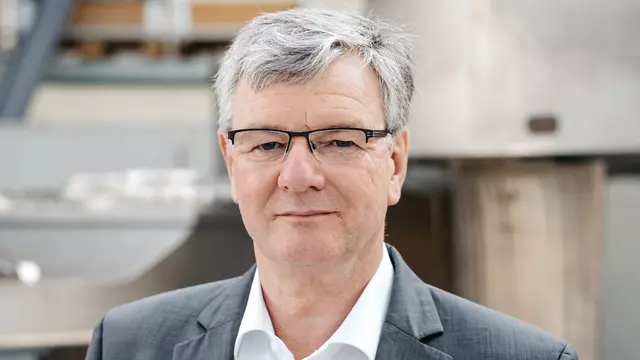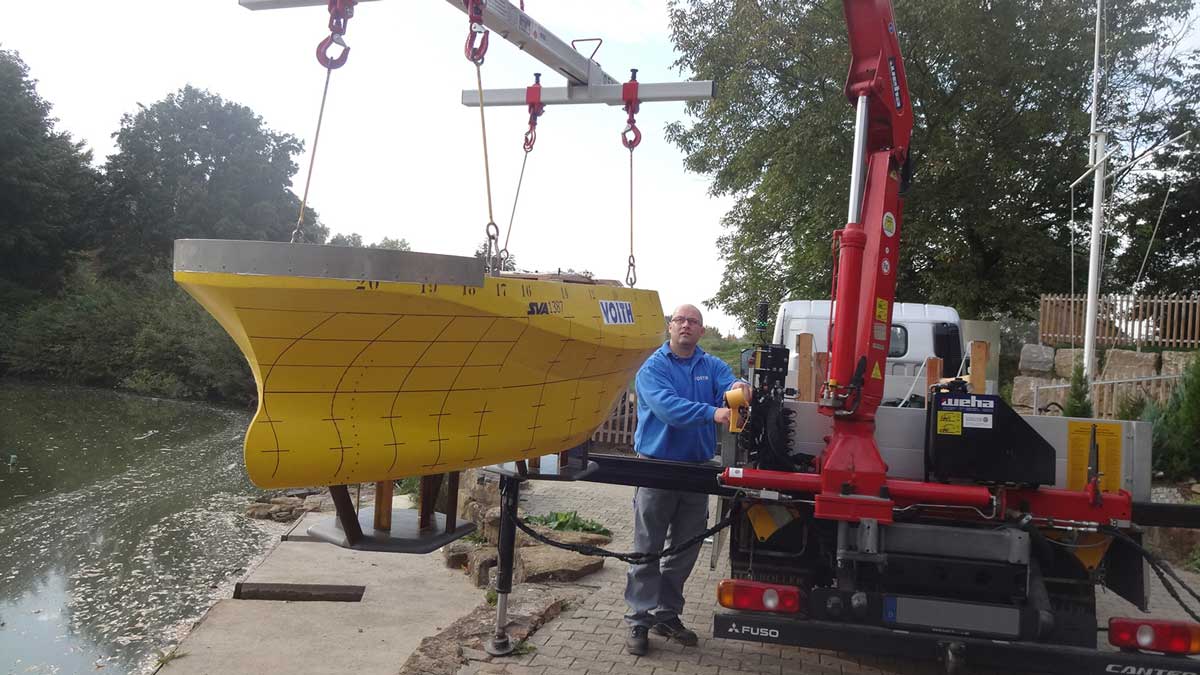Safe towing
International shipping is facing enormous challenges, with the need for increased safety and efficiency. Innovative solutions and intelligent systems for the deployment of remote-controlled tug boats will help. The collaborative FernSAMS project has been researching this issue for three years. Voith is breaking ground in unmanned shipping, too.
Scenario in the Port of Rotterdam, the largest deep-water port in Europe: A gigantic seagoing vessel passes through the waterway, 330 meters long and 45 meters wide. With a draught of 24 meters, the colossal ship is heading towards the port’s turning basin where six tugs are already waiting. The comparatively tiny assistant vessels help with docking. The tug lines fly as if by magic, dock with the bow of the cargo ship, and the little powerhouses scurry around the giant ship in a perfectly choreographed water ballet to tow it safely to its anchorage. This is nothing unusual at the Port of Rotterdam, one of the largest seaports in the world. What is unusual, however, is that there is no tug crew to be seen anywhere. The tugs are operating without any crew. They are controlled remotely by their captain who stands on the bridge of a conventional tug boat a good distance away from the ocean giant. He communicates with the captain of the large vessel by mobile radio to coordinate the tugs.
Admittedly, this is still wishful thinking. But Voith firmly believes in the trend towards remote-controlled and even autonomous navigation and therefore heads the continental project FernSAMS (Ferngesteuerte Schlepper bei An- und Ablegemanövern großer Schiffe) – the use of remote-controlled tugs during mooring and casting off maneuvers of large ships. What’s the point? Solving many problems at once.

Increasing costs
The sea route is one of the most important connections for international goods transport from and to Germany. According to forecasts, transshipment volumes are expected to increase from approximately 269 million metric tons to 468 million metric tons by the year 2030. At the same time, cost pressure on the international market is increasing, which is forcing shipping companies worldwide to use large ships. This causes bottlenecks in small ports. To ensure the safety of the port facilities and the ships, many seagoing vessels are supported by up to six assistant tugs.
With a bollard pull of 55 metric tons (normally 25), they tow the ocean giants to and from the moorings through typically narrow shipping lanes. Bigger and bigger ships push up staff costs, which puts a strain on shipping companies, especially since one tug boat is in paid operation for an average of 2500 hours per year. To ensure it is fit for operation, however, the crew is on board for an average of 8760 hours.

Serious safety risks
Even the most experienced tug boat crews are living on the edge. Fire, capsize, collision – these accidents occur on a regular basis. Particularly when the towline is handed over by hand. To do this, the tug operating at the front of the ship must navigate directly in front of the bow of the moving freighter. Harbor pilots on the bridge of the freighter coordinate this effort with the tug captains. Since the lines are under immense strain, the smallest technical problem or maneuvering error can cause the line to break or the ship and tug to collide. Replacing several tug boats in this team by unmanned ships and having them guided by remote control from on board one of the vehicles would circumvent the risk. In addition to the risk to crew, an accident in marine assistance can quickly develop into a catastrophe due to oil in the port area.
Strong team of experts
The aim of the FernSAMS collaborative project is therefore to design a remote-controlled tug boat to increase the safety and efficiency of navigation in ports. It is part of the research program on next-generation maritime technologies sponsored by the Germany Ministry for Economic Affairs and Energy (BMWI). With the Hamburg University of Technology, the Fraunhofer Center for Maritime Logistics and Services, the Federal Office for Hydraulic Engineering and a number of technology and communications specialists, Voith has brought strong partners on board.
Technology for autonomy
Dr. Jürgens notes that "along with rail transport, the shipping industry has the greatest potential for autonomization. We supply technology in this groundbreaking area, are doing research with renowned partners and getting ready to support our customers." Voith was predestined to be part of the project; with the Voith Schneider-Propeller (VSP), the company created a drive system back in 1927 that gives assistance vessels agile and accurate maneuverability due to its fast and accurate power transmission. The water tractor developed by Voith is therefore considered one of the safest types of tugs. A diesel-electric drive concept would be considerably more eco-friendly.

Enormous increase in efficiency
The (semi-) autonomous control allows the tug boats to be completely redesigned. Without crew, there is no need for common rooms, sanitary facilities, noise insulation or even the bridge. This reduces the weight of these floating powerhouses, making them even more maneuverable and providing an advantage for completely new approaches that Dr. Jürgens already has in mind.
Smart communication technology
The team of experts is not quite there yet. "The use of tug boats is very complex. Therefore, the requirements for this type of system are high," stresses project manager Dr. Jürgens. Without human experience and skill, factors such as speed, direction of travel, horsepower of the ships involved and wind and water currents must be measured precisely. This would require a secure data connection for data exchange and redundant systems in the event the enormous steel masses of the vessel to be assisted were to move between the transmitter and receiver.

Man and machine
When people hear about efficiency improvement, they quickly think of redundancies. FernSAMS has no intention of eliminating tug boat crews. "On the contrary, there are other important jobs for them," emphasizes Dr. Jürgens. Fire-fighting, oil spill response and surveillance of the port area are examples. Extensive tests with the Hamburg harbor pilots have already been run in MTC Hamburg’s realistic ship simulator. The first practical test in the Port of Rotterdam had to be postponed to a later date in 2020 due to the coronavirus crisis. To be continued.

